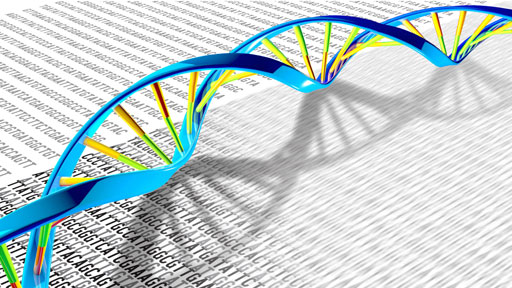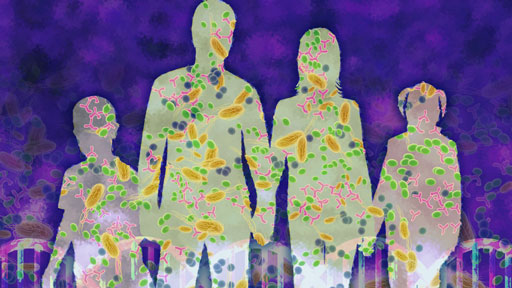Centers for Mendelian Genomics uncovering the genomic basis of hundreds of rare conditions
When the National Human Genome Research Institute and the National Heart, Lung, and Blood Institute launched the Centers for Mendelian Genomics (CMGs) program nearly four years ago, it was charged with the ambitious task of identifying the genomic underpinnings of as many Mendelian conditions as possible.
Identifying the Genomic Cause
It's a huge challenge: There are an estimated 7,300 such conditions, which are rare and usually inherited, and typically caused by a mutation in a single gene. So far, researchers have identified the genomic causes for only about half.
Individually, a rare disease may affect only a handful of families. Collectively, rare diseases impact 20 to 30 million people in the U.S. alone.
Thanks to an international partnership with more than 500 investigators in 36 countries, CMG investigators have made significant inroads in discovering genes underlying Mendelian conditions. In studying nearly 9,000 families, they have uncovered 470 new, previously unknown conditions and learned important details about the development of many others that scientists had described before.
They have also made more than 960 discoveries linking specific genomic changes with diseases. These include 375 previously not associated with any Mendelian conditions. As a result, they have found genomic answers to disorders where, in many cases, none had existed previously, helping patients, families and their physicians better understand and manage the conditions that affect them.
In a review article that appeared online July 9 in the American Journal of Human Genetics, CMG investigators described the program's progress and the breadth of Mendelian gene discovery to date. The authors also ruminated on the lessons learned, challenges and the opportunities for the future.
The CMGs include centers at Yale University School of Medicine in New Haven, Connecticut, the University of Washington in Seattle, and a joint program between Johns Hopkins University School of Medicine in Baltimore, and Baylor College of Medicine in Houston. Researchers and physicians who are working with families with a known Mendelian condition or one newly described by a CMG, or others, submit DNA samples to the centers for DNA sequencing - or more specifically, exome or whole genome sequencing. The exome includes all the protein-coding genes in the genome. Proteins are the work horse of the cell, with wide-ranging functions. Whole genome sequencing reveals an individual's entire DNA make-up.
Initially, the CMG investigators were unsure what the scope of their task would be. "When the project began, most of Mendelian genetics was still undiscovered," said Richard Lifton, M.D., Ph.D., chair and Sterling Professor of Genetics at Yale University in New Haven, and principal investigator of the Yale center. "One question was whether the major task at hand was to understand the genetics of the recognized Mendelian conditions or if there were many more new ones to be discovered and explained as well. Since then, we've learned that there are vastly more Mendelian conditions than previously recognized. It's possible that virtually all of the genes in the human genome will have some kind of negative health effect when lost."
By some accounts, the Mendelian centers have accomplished more than anticipated, said senior author Michael Bamshad, M.D., chief of the division of genetic medicine at the University of Washington and CMG principal investigator.
"Scientists were skeptical when the program started in 2011," he said. "Exome sequencing had not really gone into production pipelines." As DNA sequencing costs dropped, scientists were able to move exome sequencing into efficient, large-scale production. "We knew that discovery would depend on identifying Mendelian conditions, and DNA collection that had already been done to date. We were hopeful that investigators would collaborate with us, and in three years, we have been able to examine 1,000 Mendelian phenotypes. That's remarkable."
Insights into the biology of disease
Studying Mendelian conditions and characteristics has taught the researchers a great deal about the biology of disease.
"Knowing that there is a relationship between a gene and a disease has enabled us to probe the development and common pathways behind diseases," Dr. Lifton said. "These are starting points for understanding disease and human biology in general."
The authors describe one such example of a previously unrecognized pathway that regulates the balance between salt reabsorption and potassium secretion in the kidney. The pathway was uncovered by studying genes that were mutated in a rare Mendelian form of hypertension in which the kidneys cannot regulate salt reabsorption and balance in the blood.
Many Mendelian traits are highly genetically heterogeneous, meaning that mutations in hundreds of genes can cause similar diseases. In some cases, a particular gene mutation may cause a condition in one family member while having a lesser effect on another. "This means that the size of the task is greater than thought," said Dr. Lifton. "Thousands of families will have to be studied to provide definitive evidence that a single gene mutation is responsible for a condition."
There's also the concept of "phenotypic expansion." In this case, unrelated individuals appear to have different diseases, but actually have the same Mendelian condition. Large DNA sequencing studies have enabled the CMGs to discover hundreds of individuals who "expand" a phenotype, or physical characteristics, of a previously described Mendelian condition.
CMG studies have also revealed new details of ways Mendelian conditions can be inherited.
"Genomic approaches such as whole exome sequencing have helped describe new methods of inheritance, including digenic (two genes) models of inheritance and blended phenotypes," said Jim Lupski, M.D., Ph.D., D.Sc., Cullen Professor of Molecular and Human Genetics, co-author and a principal investigator at the Baylor-Hopkins CMG. Digenic inheritance involves two inherited genetic changes that interact to cause a single disease. The CMG researchers found a small but significant number of patients with a known disease may actually have more than one condition, which they refer to as a "multi-Mendelian" or "blended phenotype."
CMG scientists have also discovered examples of mutations in a gene causing two or more separate conditions. "Sometimes a gene mutation or a variant causes one disease, whereas a different mutation in the same gene causes a different condition," Dr. Lupski said.
In addition, "The field has discovered the important roles of de novo, or new, mutations causing Mendelian disease," said co-author David Valle, M.D., director of the McKusick-Nathans Institute of Genetic Medicine at the Johns Hopkins School of Medicine and a Baylor-Hopkins CMG principal investigator. These are genetic mutations that are not inherited. "No one else in the family has the disease because one parent or a child has a new mutation."
The investigators see a number of challenges ahead in identifying and understanding the genomics of Mendelian disease. "The only way that the centers will continue to be successful will be with the broad-based collaborations worldwide, and the continued sharing of data by clinicians and families," said Dr. Bamshad.
Dr. Lupski said that better methods are needed to characterize copy number variations (CNV), which are abnormal numbers of genes in a cell, and variations in the structures of genes, all of which can contribute to Mendelian conditions. Dr. Lifton wonders about the potential effects of the non-protein-coding regions of the genome on Mendelian disease. "It's still an open question as to how much influence mutations in non-coding elements that regulate gene activity will have on disease," he said.
The effects of environmental triggers in Mendelian disease are another area ripe for research. Certain occupations such as mining or farming, or lifestyle choices like smoking might contribute to disease in individuals with an underlying susceptibility from a Mendelian condition that wouldn't manifest itself otherwise, Dr. Lifton said.
"We're on the threshold of new explanations of disease inheritance and development," said Dr. Lupski. "These kinds of discoveries will all help drive new advances in precision medicine and are opening up new areas of research."
Read the Article
Chong JX, Buckingham KJ, Jhangiani SN, Boehm C, Sobreira N, Smith JD, Harrell TM, McMillin MJ, Wiszniewski W, Gambin T, Coban Akdemir ZH, Doheny K, Scott AF, Avramopoulos D, Chakravarti A, Hoover-Fong J, Mathews D, Witmer PD, Ling H, Hetrick K, Watkins L, Patterson KE, Reinier F, Blue E, Muzny D, Kircher M, Bilguvar K, López-Giráldez F, Sutton VR, Tabor HK, Leal SM, Gunel M, Mane S, Gibbs RA, Boerwinkle E, Hamosh A, Shendure J, Lupski JR, Lifton RP, Valle D, Nickerson DA; Centers for Mendelian Genomics, Bamshad MJ. The Genetic Basis of Mendelian Phenotypes: Discoveries, Challenges, and Opportunities. Am J Hum Genet, 97. 199-215. 2015. [Full Text]
Related Content
Last updated: August 6, 2015



